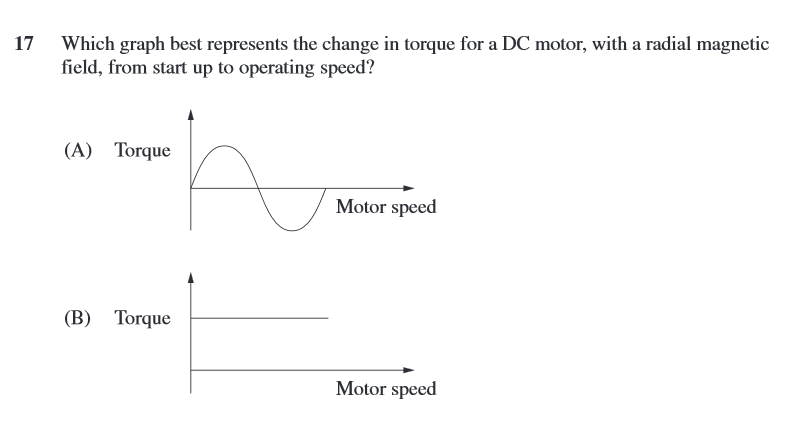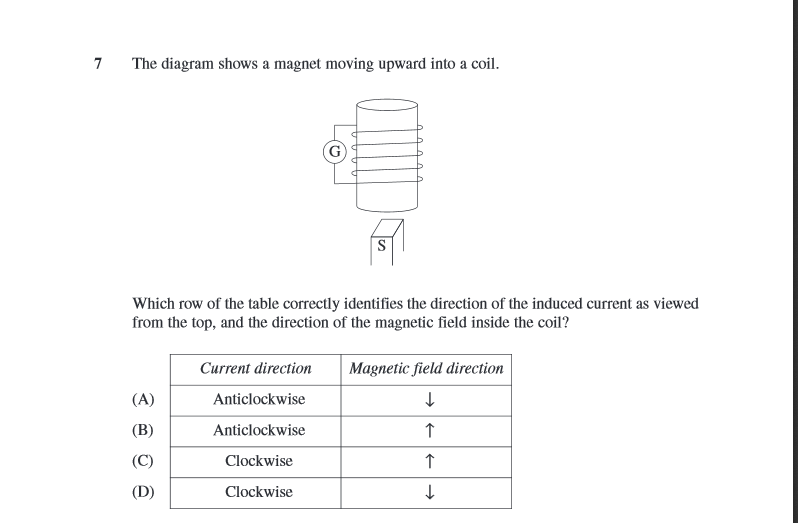-
Best of luck to the class of 2025 for their HSC exams. You got this! Let us know your thoughts on the HSC exams here
Make a Difference – Donate to Bored of Studies!
Students helping students, join us in improving Bored of Studies by donating and supporting future students!
HSC Physics MC Thread (1 Viewer)
- Thread starter Mr_Kap
- Start date
JavaScript
Member
- Joined
- Oct 16, 2015
- Messages
- 83
- Gender
- Male
- HSC
- 2015
Because a motor has almost instant torque and the torque doesn't decrease if its radial. The motor effect happens at every angle (in a perfect motor).
Why is it B?
i thought it would be an INCREASING straight line.
Because it is a radial magnetic field and THETA is always 0 degrees it must be some form of straiht line, but i thought if it speeds up then the torqu needs to be larger
That's why its a straight line.
Back EMF.wait, so why is the answer a straight line with NEGATIVE gradient.
JavaScript
Member
- Joined
- Oct 16, 2015
- Messages
- 83
- Gender
- Male
- HSC
- 2015
What???wait, so why is the answer a straight line with NEGATIVE gradient.
Answer's not actually (B), he misread it.Because a motor has almost instant torque and the torque doesn't decrease if its radial. The motor effect happens at every angle (in a perfect motor).
That's why its a straight line.
more explanation please? (if possible)Back EMF.
JavaScript
Member
- Joined
- Oct 16, 2015
- Messages
- 83
- Gender
- Male
- HSC
- 2015
Dat feel when you're shit lolAnswer's not actually (B), he misread it.
JavaScript
Member
- Joined
- Oct 16, 2015
- Messages
- 83
- Gender
- Male
- HSC
- 2015
How is it A??
It's (D), as he said in his edit.How is it A??
JavaScript
Member
- Joined
- Oct 16, 2015
- Messages
- 83
- Gender
- Male
- HSC
- 2015
Ohh. Yeah it will be a line going down cause back emf will slow it down.It's (D), as he said in his edit.
godofindolence
Member
- Joined
- Sep 17, 2015
- Messages
- 71
- Gender
- Male
- HSC
- 2015
Remember Faraday's law which states that relative movement of a conductor in a magnetic field results in induced EMF. Lenz's law further refines this by stating that the induced EMF produces a magnetic field that opposes the initial change in flux.more explanation please? (if possible)
Thus as a motor is spinning, the coils in the rotor cuts through the magnetic field in the stator. This creates induced EMF by Lenz's law. The magnitude of this opposes the initial change, so by necessity, this results in the reverse of the supplied current. (Just use right hand rule on one side of the coil, and flip the forces). This is back EMF.
Lenz's also states that the induced EMF is proportional to rate of change of flux, (negative change in flux over change in time). Thus, as the motor spins faster and faster, the rate of change of flux increases, and the magnitude of the back EMF increase. Thus the supplied current and the induced current cancels each other out, reducing the total current.
Since torque = nBIA cos thetha and I is the decreasing variable, this represents a linear decrease as rotational speed goes up and back emf increases.
Jk already explained above
Last edited:
LOL don't worry the same thing has happened to Zlatman heaps of times recentlyRemember Faraday's law which states that relative movement of a conductor in a magnetic field results in induced EMF. Lenz's law further refines this by stating that the induced EMF produces a magnetic field that opposes the initial change in flux.
Thus as a motor is spinning, the coils in the rotor cuts through the magnetic field in the stator. This creates induced EMF by Lenz's law. The magnitude of this opposes the initial change, so by necessity, this results in the reverse of the supplied current. (Just use right hand rule on one side of the coil, and flip the forces). This is back EMF.
Lenz's also states that the induced EMF is proportional to rate of change of flux, (negative change in flux over change in time). Thus, as the motor spins faster and faster, the rate of change of flux increases, and the magnitude of the back EMF increase. Thus the supplied current and the induced current cancels each other out, reducing the total current.
Since torque = nBIA cos thetha and I is the decreasing variable, this represents a linear decrease as rotational speed goes up and back emf increases.
Jk already explained above
InteGrand's LaTex skills are too OP

In this question, shouldn't the current made in the coil generate a magnetic field such to oppose the magnet, hence the magnetic field in the coil will be down (as the bottom of the coil needs to be south to oppose the south end of the magnet).
This means when i use the right hand curl rule, the current is CLOCKWISE. So the answer should be D.
HOWEVER the answer is actually B. Why??? What am i doing wrong??
keepLooking
Active Member
- Joined
- Aug 25, 2014
- Messages
- 474
- Gender
- Male
- HSC
- 2015
I need this answered properly too. The moment when I realise I have the 2014 Success One and it doesn't contain the 2014 paper..bump
anyone??
In this question, shouldn't the current made in the coil generate a magnetic field such to oppose the magnet, hence the magnetic field in the coil will be down (as the bottom of the coil needs to be south to oppose the south end of the magnet).
This means when i use the right hand curl rule, the current is CLOCKWISE. So the answer should be D.
HOWEVER the answer is actually B. Why??? What am i doing wrong??
DattMyball
New Member
- Joined
- Nov 4, 2014
- Messages
- 5
- Gender
- Male
- HSC
- 2015
In this question, shouldn't the current made in the coil generate a magnetic field such to oppose the magnet, hence the magnetic field in the coil will be down (as the bottom of the coil needs to be south to oppose the south end of the magnet).
This means when i use the right hand curl rule, the current is CLOCKWISE. So the answer should be D.
HOWEVER the answer is actually B. Why??? What am i doing wrong??
You might have the right hand rule the wrong way. I think the fingers point in the north direction of the b-field so the field goes up
Last edited:

